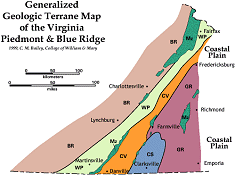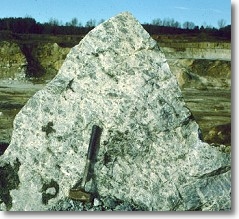 |
|||
he Piedmont is the largest physiographic province in Virginia. It is bounded on the east by the Fall Zone, which separates the province from the Coastal Plain, and on the west by the mountains of the Blue Ridge province. The province is characterized by gently rolling topography, deeply weathered bedrock, and a relative paucity of solid outcrop. Rocks are strongly weathered in the Piedmont's humid climate and bedrock is generally buried under a thick (2-20 m) blanket of saprolite. Outcrops are commonly restricted to stream valleys where saprolite has been removed by erosion. The topography becomes somewhat more rugged with proximity to the Blue Ridge, where local monadnocks of more resistant rock occur. A variety of igneous and metamorphic rocks make up
the bedrock of the
Piedmont province
Many rocks exposed in the Piedmont have a complex geologic history and some may have formed in regions outside of North America. Packages of rock with distinctly different geologic histories, separated from one another by fault zones, are called geologic terranes. The oldest rocks are ~1100 million years old, and occur in an area just west of Richmond known as the Goochland terrane. Rocks of the Goochland terrane bear many similarities to Grenville-age rocks in the Blue Ridge province, including the presence of anorthosite in the small Montpelier body. Other terranes include Cambro-Ordovican igneous rocks that are interpreted to be the remains of an ancient volcanic arc (much like the present-day Aleutian Islands) that collided with and accreted onto the eastern edge of North America during a period of Appalachian mountain building. Granitic rocks of Paleozoic age are common, and also formed during this time. Many terranes have experienced multiple episodes of metamorphism and deformation, resulting in a complex geologic province, and leaving many outstanding problems to be answered. Notable economic resources in the Piedmont province include high quality slate in the late Ordovician Arvonia Formation, which also hosts one of the world's largest kyanite mines at Willis Mountain in Buckingham County. |


